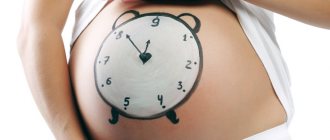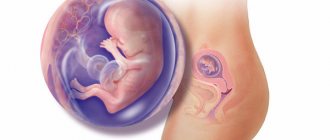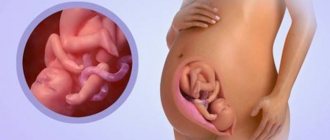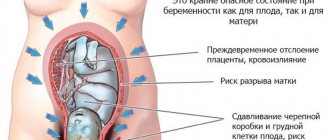What changes occur in the female body at 42 weeks of gestation
During the last week of pregnancy, the mother's body is actively preparing for the upcoming birth. The pelvic bones gradually diverge, so that a fairly large fetal head can pass through the birth canal. In this case, the expectant mother may experience pain in the lower abdomen and lower back. The cervix is also preparing for the upcoming birth process: it becomes softer, shorter and can begin to open at any time. Labor is controlled by the hormones vasopressin and oxytocin, the levels of which begin to increase on the eve of childbirth.
If at 42 weeks of pregnancy the baby has not yet been born, there is no need to worry. Pregnancy is considered post-term from 43 weeks. Most likely, an error was made when calculating the estimated due date.
Many expectant mothers are interested in the question of why the 42nd week of pregnancy has arrived, but labor does not begin and there are no contractions? There may be several reasons for this:
- Incorrect calculation of the expected date of labor. The correct date of delivery is determined only in 5% of cases. This is due to the fact that only some women can indicate the exact date of fertilization;
- Factors that influence gestational age. The duration of gestation depends on the length of the menstrual cycle, the day of ovulation, the presence of possible endocrine disorders, the woman’s age and genetic factors. For expectant mothers with a menstrual cycle longer than 28 days, pregnancy over 40 weeks is not considered post-term. Women whose menstrual cycle lasts less than 28 days give birth before the due date;
- Complications of pregnancy in the first trimester of gestation. The presence of various abnormalities and disorders in the early stages of pregnancy increases the likelihood of post-term pregnancy.
Medical supervision
After 38 weeks, women are required to undergo weekly consultation and examination by a doctor. A qualified physician, if necessary, prescribes instrumental methods, ultrasound scanning with Dopplerography. The data obtained from ultrasound and examination allows us to clearly determine what it is: a prolonged or post-term pregnancy.
To do this, certain signs are studied:
- Thinning and deformation of the placenta.
- The amount of amniotic fluid.
- Presence of meconium in amniotic fluid.
- The degree of readiness of the cervix.
- The nature of fetal cardiac activity.
- The discharge from the mammary glands (milk or colostrum) is taken for analysis.
Having summarized the information, the gynecologist draws a conclusion about what type of protracted pregnancy will have to be dealt with.
The need for obstetric and gynecological intervention
If it is discovered that pregnancy is being delayed for reasons other than physiological, then doctors and the pregnant woman are faced with a choice of what to do: either wait a little longer or give birth immediately.
Dangers of post-term pregnancy:
- After 42 weeks, the placenta ages and is unable to provide the fetus with oxygen and nutrition, and the risks of hypoxia are high.
- A mature fetus can reflexively inhale amniotic fluid with meconium, which will complicate its independent breathing at birth. Aspiration (inhalation) of meconium makes it difficult for the baby to start life with artificial ventilation.
- An overmature child often has a lot of weight (about 30% of normal), his skull bones ossify, which interferes with movement through the birth canal and leads to birth injuries.
- Some post-term babies, on the contrary, begin to lose weight (with significant placental insufficiency).
- The amount of amniotic fluid decreases, which threatens the umbilical cord.
- The fetal skin loses lubrication and becomes prone to injury, especially in low-hydramnios conditions.
A truly post-term pregnancy is determined not only by the extra weeks, but is accompanied by signs of overmaturity of the child himself.
Such a baby does not gain weight well after birth, the skin is dry and wrinkled without lubrication, and the eyes are open. These children have long nails and hair and are active. Skin color may have a yellowish or grayish tint.
What happens to the baby at 42 weeks of pregnancy
At this stage, the fetus continues to grow and increase body weight. Now his weight is from 3.5 to 4 kg, and his height is 52-57 cm. The child is already quite large, so the only difficulty that may arise against the background of his prolonged stay in the mother’s womb is the slow and more difficult passage of the baby through the birth canal. The skull bones become harder. This can lead to a protracted labor, long contractions, and birth injuries to the newborn.
It should be taken into account that post-term pregnancy can affect the health of the baby. After 42 weeks, the placenta becomes old, which leads to disruption of the supply of oxygen and nutrients to the baby. This can cause fetal hypoxia and disruption of brain activity.
When the baby does not have enough oxygen, he involuntarily begins to excrete feces into the amniotic fluid. The entry of meconium along with amniotic fluid into his body can lead to the fact that after birth the child will not be able to breathe on his own. In such a situation, the baby is prescribed antibacterial drugs and ventilated.
Post-term or prolonged pregnancy
Prolonged pregnancy is a type of post-term pregnancy, in which the gestational age increases by 10-14 days or more from the expected date of birth.
About 10% of pregnant women reach the 42nd week. At this stage, pregnancy can be either post-term or prolonged. One of the common reasons for prolongation of pregnancy is an incorrectly determined date of conception. And even if you know exactly when the child was conceived, this is not a reason to worry. For example, late fetal ripening is typical for a woman with a menstrual cycle of more than 28 days.
There are signs by which you can determine that the fetus is post-term:
- dry, flaky and wrinkled skin;
- lack of vernix flakes in the amniotic fluid;
- too dense skull bones;
- the presence of suspensions of meconium (feces) in the amniotic fluid;
- large body weight;
- long nails, scratched face;
- lack of amniotic fluid;
- old placenta that does not provide normal nutrition to the fetus;
- bluish or green tint of baby's skin and membranes.
The following examination methods will help determine whether the fetus is post-term:
- Ultrasound examination (ultrasound) is necessary to determine the condition of the placenta, as well as to clarify the size and location of the fetus;
- cardiotocography allows you to record the baby’s heart rate and monitor uterine contractions;
- Using Doppler sonography, doctors evaluate the functioning of the placenta and uterine arteries;
- aminoscopy - examination of the fetal bladder using an aminoscope - is used to determine the amount of amniotic fluid and the presence of meconium and cheese-like lubricant in it.
It is worth remembering that a truly post-term pregnancy at 42 weeks is not a very common occurrence.
Why am I post-term
As a rule, this question worries all women who have reached 42 weeks. Sometimes excessive excitement turns into severe fear, which can also cause a delay in labor. In addition, other factors may contribute to postmaturity:
- insufficient amount of hormones responsible for the onset of labor;
- violation of fat metabolism;
- diseases of the genitourinary system;
- diseases of the gastrointestinal tract;
- psychological trauma;
- hereditary factors.
There are times when an expectant mother is so afraid of a painful birth that it is delayed.
If you are tormented by fears, you need to try to calm down, trust your body and your baby. Even if he does not want to be born on time, you will receive qualified medical care in the maternity hospital. Explain this to annoying relatives who are constantly wondering whether you will give birth soon.
What are the dangers of post-term birth?
Late labor can pose a threat not only to the baby, but also to the health of the mother. While the fetus is in the mother's womb, the bones of its skull continue to harden. Therefore, while passing through the birth canal, it will be more difficult for its head to take a comfortable shape. And this is fraught not only with a difficult and long labor, but also with a head injury to the baby.
As the baby and its nutritional needs continue to grow, the placenta continues to age. The baby may lack nutrition and oxygen. When the fetus is starved of oxygen, its intestines can reflexively release original feces - meconium - into the amniotic fluid. In this case, the child can take his first breath, which he must take while already outside the mother’s womb. As a result, the baby may swallow amniotic fluid containing feces. He may need antibacterial therapy and urgent connection to a ventilator.
Post-term pregnancy also poses a risk to the mother's health. As a rule, labor activity during such a pregnancy is weak. Childbirth can occur with complications and even bleeding. Sometimes the fetus grows so large that the woman has to give birth by caesarean section. And if she was prescribed a natural birth, then it could end with numerous ruptures.
What to do if pregnancy is prolonged
If your doctor determines that you are postterm, then you will have a cesarean section or labor induction. There are many methods for stimulating labor, and the choice of method depends on the specific situation. So, the main methods of inducing labor include:
1. Methods used in medical settings:
- administration of the hormone oxytocin
Administration is carried out using a dropper. A certain dose of the drug causes uterine contractions. When sufficiently intense contractions are achieved, the administration of the hormone is stopped. The disadvantage of childbirth with oxytocin is that the woman in labor has to lie under a drip.
- administration of the hormone prostaglandin
This hormone, contained in male sperm, causes uterine contractions. In addition, it softens the cervix, which makes labor easier. However, contractions caused by prostaglandins are usually much stronger and more painful than natural ones.
- amniotomy
Opening the amniotic sac is done when the birth canal is ready for childbirth, but there are still no contractions. After the bladder is punctured, labor usually occurs within the next 24 hours. With amniotomy, there is a risk of infection in the fetus.
2. Methods used at home:
- sex
As already mentioned, prostaglandin is present in male sperm. It softens the cervix and causes contractions. But you should not use this method if the mucus plug has already come off, because this is fraught with consequences in the form of infection of the fetus.
- nipple massage
Massaging the nipples of the breast provokes the production of the hormone oxytocin and uterine contractions. This action is used when the birth canal is already prepared for the birth of the baby.
- laxative
Using an enema or laxative, you can gently and naturally start the labor mechanism.
Natural methods of inducing labor:
Do not try to induce labor yourself! This should only be done under medical supervision, taking into account all possible contraindications.
If you want to speed up labor, don't forget to move, walk outside and take steps. This will better prepare your body for childbirth. The decision to perform a caesarean section is made when the baby’s head is too large, fetal hypoxia is observed, the amniotic fluid has acquired a greenish tint, and in some other situations.
The forty-second week is not always a reason to perform a cesarean section and induce labor. If the placenta is still functioning well and both mother and baby are doing well, doctors may be inclined to allow labor to begin naturally. The likelihood of labor starting this week is quite high. Therefore, you may be advised to expect to meet your baby at the hospital.
What does induction of labor lead to? Why do you need to prepare for childbirth? EXPERT Speaks
Feelings of the expectant mother at 42 weeks of gestation
Most women at this stage begin to fall into a depressive state. Anticipation of childbirth, worries and fatigue lead to apathy and psycho-emotional disorders.
Also, the expectant mother may encounter a number of unpleasant sensations:
- Stool disorder (constipation, diarrhea). Such disorders are caused by hormonal changes and pressure from the enlarged uterus on the organs of the digestive system;
- Edema. At this stage, more than 70% of pregnant women suffer from swelling. With normal blood pressure and the absence of protein in the urine, this condition is not dangerous;
- Development of hemorrhoids. It usually occurs due to pressure from the uterus on the perineum and intestines.
If the pregnancy is progressing normally, the expectant mother can stay at home until regular contractions occur. If amniotic fluid breaks, you should go to the maternity hospital without waiting for contractions to appear. If a mucus plug falls out, there is no need to rush to the maternity hospital. As a rule, it leaves a few days before the onset of the birth process.
Also, the expectant mother needs to remember about the dangerous symptoms of the 42nd week of pregnancy, which should immediately contact a doctor if they occur:
- Bloody discharge from the genital tract;
- Continuous tone of the uterus, accompanied by severe pain in the lower abdomen;
- Frequent attacks of headaches, increased blood pressure, blurred vision, nausea, vomiting;
- Complete absence or excessively active fetal movements.
Expectant mother - condition and feelings
The emotional state of a woman can be described as expectation and anticipation of the birth of a baby. Nowadays, the moral support of the attending physician and loved ones is especially important for the expectant mother. The main thing for her is a positive attitude, which will contribute to the successful course of labor.
A drooping stomach still causes nagging pain in the lower abdomen, in the lumbar region and perineum. Some suffer from varicose veins and hemorrhoids. The skin of the abdomen itches a lot (reasons why the skin of the abdomen itches), and the arms and legs go numb. Swelling is often added to the bulkiness and sluggishness of the body.
With rare exceptions, the norm for a pregnant woman at this stage is training contractions, which at any moment can turn into real ones. You can recognize the latter by the same time intervals between contractions and intense pain. Other warning signs of labor may also occur: leakage of colostrum, frequent urge to urinate, rupture of a plug, and slight weight loss.
How to recognize contractions
Recommendations and tips
- Make sure once again that you are ready to go to the maternity hospital. You must have all the necessary documents and things with you.
- Even if you feel great, do not neglect visiting your doctor.
- Make time for rest.
- Stick to proper nutrition and eat heavy foods less often.
- Monitor the amount of fluid you drink throughout the day.
- Learn breathing techniques used during childbirth.
- Mentally prepare your loved ones for your return from the hospital with a new family member.
- Try to think positively.
The 42nd week of pregnancy is a period that not all expectant mothers can experience. If your pregnancy has reached this stage, take it as an opportunity to better prepare for the birth of your long-awaited baby.
← 41 week Childbirth →
Medical examination at 42 weeks of gestation
During this period, the expectant mother must visit a doctor and have her urine tested. To monitor the condition of the fetus and mother, the following studies may be prescribed:
- CTG (cardiotocography). It is carried out to assess the baby’s cardiac activity;
- Ultrasound scanning. Allows you to determine the location and degree of development of the fetus, as well as visualize the condition of the uterine cervix. During ultrasound diagnostics, the doctor can detect pathological abnormalities that require stimulation of labor;
- Amnioscopy. Prescribed to determine the condition of amniotic fluid and placenta.
If the above studies do not reveal any abnormalities, the doctor will recommend waiting until natural delivery occurs. If dangerous conditions and pathologies are detected at 42 weeks of pregnancy, the obstetrician-gynecologist decides on the advisability of inducing labor or cesarean section.
How is the baby feeling?
If the placenta is not yet old and is able to deliver nutrients to the baby in full, the baby feels great. Over the past week, he has grown another 1 cm. His weight could remain the same, or it could increase by 200-500 grams.
The child's hair and nails grow. His eyes are open, he moves his legs and arms quite often, and plays with the umbilical cord. The mother feels all movements of the fetus well.
The baby's bones are getting stronger, the skull is becoming more and more solid. This can cause prolonged labor and pushing. In addition, from 40 weeks the baby has become a little larger, and it is difficult for a large fetus to move along the birth canal.
Possible pregnancy problems at 42 weeks
The risk of developing eclampsia (late gestosis) and placental abruption remains at this stage. In some cases, the labor process does not begin due to a deficiency of the hormones that regulate it (vasopressin and oxytocin). In such a case, the woman may be prescribed corrective hormonal therapy.
If there is a suspicion of post-term pregnancy, the expectant mother is offered to induce labor.
Stimulation of labor in a maternity hospital
In the maternity hospital, labor is induced using oxytocin. This is a drug that, together with prostaglandin (a female hormone), causes contraction of the uterine muscles. If after this contractions do not appear at 42 weeks of pregnancy, and the cervix begins to dilate, the bladder is punctured.
Induction of labor can also be done at home. The best method for accelerating labor is considered to be unprotected sexual intercourse. Male sperm contains prostaglandins, and during stimulation of the nipples the hormone oxytocin is produced, which together can cause uterine contractions. In addition, during arousal in the pelvic organs, blood circulation increases, which can provoke the onset of contractions and an increase in the tone of the uterus.
You can also stimulate labor at home by performing useful physical activities (dancing, climbing stairs). You can try to stick to a diet rich in vegetable oil and vegetables. Increased intestinal peristalsis can cause uterine contractions and the onset of contractions. In order not to complicate the birth process and not harm the baby, the listed methods of inducing labor should be used extremely carefully and only after consultation with a doctor.
What should you do with the normal version?
So, the woman is pregnant, 42 weeks pregnant. However, there are no signs of labor yet. The condition is alarming, the fear of childbirth overcomes the fatigue from waiting.
The first thing to do is not to give in to stress. It further aggravates all health problems. You should calm down: there is a whole 43rd week ahead, when physiological labor can begin.
Children born during this period are born healthy in 95% of cases and are no different from their earlier “colleagues”.
Features of behavior
If there are no abnormalities in the fetus, and the doctor does not consider the pregnancy to be post-term, he will give you time and will not artificially induce labor. A woman can independently speed up the process of giving birth to a child:
- Any physical activity that does not cause discomfort. For example, walking in the fresh air, cleaning the apartment.
- Making love without protection. Being close to a child's father works wonders. Blood flow to the pelvis and muscle tone of the uterus can awaken the sleeping nature and speed up the onset of labor. Stimulation of the nipples ensures that the body produces oxytocin, and sperm softens the cervix due to the content of the hormone prostaglandin. This way the future dad, who is involved in the conception, will help speed up the birth.
- By adjusting your menu. A vegetable diet and salads with vegetable oil have worked well. Active bowel function is a good stimulant to trigger the expected labor.
- Sometimes, to stimulate labor, the doctor may recommend giving a cleansing enema or using castor oil.
For any pregnancy, especially a protracted one, all these measures should be discussed with your doctor in advance.
Health Features
The support of loved ones with a positive attitude is important. There is no need to finish her off with questions: “How are you? Has not yet given birth?". The woman has a hard time: her stomach is large and the center of gravity has again shifted due to its lowering. The pelvic bones physiologically move apart, the cervix shortens and softens, and other processes occur to prepare the body for childbirth.
You need to be prepared for some features of this period:
- Swelling of the legs may increase, and massage can help.
- Intestinal problems (constipation) are typical.
- Varicose veins and hemorrhoids can worsen. All this is due to the large size of the fetus and its pressure on the organs and vessels in the pelvis.
- The discharge intensifies and has a clear or whitish mucous appearance. The smell is sour.
If pathological purulent discharge with an unpleasant odor appears, you must inform your doctor.
To prevent infection of the child in the birth canal, its sanitation (elimination of harmful microbial flora) is required.
Sometimes lumps of thick mucus come out - this is a plug coming out of the cervix, which indicates an imminent birth.
Beginning of labor
If the maternity hospital is located close to home, then you can go there after the start of regular contractions. Don’t forget to take documents and things collected for the maternity hospital. Don’t panic: what was expected at 42 weeks is happening – labor begins.
A woman’s appetite is usually reduced at this time, but before giving birth she needs to eat to have strength. You can eat yogurt, a piece of chocolate, or whatever you want.
Prohibitions and recommendations at 42 weeks of pregnancy
During this period, it is important to maintain composure and calm. In the last weeks of pregnancy, this is quite difficult to do, but in some cases it is emotional imbalance that provokes inhibition of labor. Walking in the open air, watching your favorite movies, reading books or calm music can help you relax.
Nutritional Features
Many pregnant women experience decreased appetite this week. Childbirth is a difficult process that requires a lot of energy and strength from a woman, so you need to try to eat something. This could be a piece of chocolate, yoghurt, fruit or cake. The main thing is not to starve and eat a little every 2-3 hours. If possible, the diet should include meat and fish dishes, dairy products and a variety of cereals.
Taking vitamins
Vitamins that were prescribed by a doctor during pregnancy (calcium, vitamin D, multivitamin complexes) can be taken after childbirth. If necessary, they are replaced with drugs for nursing.
Sex at 42 weeks pregnant
As a rule, most expectant mothers have a significantly reduced sex drive this week, due to fatigue and anxiety. Intimate relationships are a safe and natural way to stimulate the birth process. Sexual contacts this week are allowed for women whose pregnancy proceeds without deviations or pathologies. After the mucus plug has passed, the risk of infection of the membranes increases significantly, so it is better to use a condom or carefully monitor the hygiene of your intimate areas.
Physical activity
Moderate physical activity is beneficial at any stage of pregnancy. In recent weeks, most exercises become unbearable for a woman. Walking in the open air will help keep your body in good shape. You can also do breathing exercises and Kegel exercises. Trying to stimulate labor through physical activity is not recommended. This may affect the delivery process.
Medical procedures, taking medications
During this period, any medical manipulations should be carried out under the supervision of a specialist. Taking any medications without a doctor's prescription is not recommended. If complaints and pathological symptoms arise, it is better to consult a doctor who, taking into account the potential benefits for the mother and possible harm to the fetus, will select the safest medicine.
If there are no signs of labor before the end of the 42nd week of pregnancy, you should contact an obstetrician-gynecologist. The doctor will conduct the necessary examinations, assess the health of the fetus and the expectant mother, and also develop tactics for further action.
Frequently asked questions on the forums
1:
Q: What are the signs of labor? It's already 42 weeks, no contractions
A: Before giving birth, the belly should drop and the mucous plug should come away - these are the most noticeable changes in the pregnant woman’s body and are observed 1-2 days before the upcoming birth. The mucus plug can come off all at once, which will be immediately noticeable, or it can come off several times, and the woman will notice heavy mucus discharge. Just before labor, your water breaks and contractions begin.
2:
V.: I’m tired of being pregnant. It's 42 weeks and no signs of labor. How can you induce contractions?
A: At 42 weeks, your doctor should suggest hospitalization and medical induction of labor. The period is already quite long, and it is recommended to seek medical help if labor has not yet begun naturally. With such stimulation, the process of giving birth to a baby occurs naturally. The only drawback is the not very pleasant procedures for preparing the cervix and stimulation.
3:
Q: What is the danger of post-term pregnancy at 42 weeks for the baby?
A: Not every pregnancy at 42 weeks is post-term. Only a doctor can make such a diagnosis after a thorough examination and examination of the fetus, placenta, and amniotic fluid. Pregnancy that is postterm leads to oxygen starvation of the baby, dryness and flaking of its skin, and can also cause various birth injuries to the mother and child and birth hemorrhage.
What does the belly look like at 42 weeks pregnant?
Video: Duration of Pregnancy | Childbirth at 42 Weeks Is this possible? Doctor's recommendations
Attention!
This article is posted for informational purposes only and under no circumstances constitutes scientific material or medical advice and should not serve as a substitute for an in-person consultation with a professional physician.
For diagnostics, diagnosis and treatment, contact qualified doctors! Number of reads: 934 Date of publication: November 28, 2017
Gynecologists - search service and appointment with gynecologists in Moscow
Water
The forty-second week of pregnancy, at this stage the girl may leak water, so you should pay attention to the amount of discharge and the nature. The discharge at this stage will be liquid and translucent, but if it is not ordinary discharge, but water, then mommy will have a lot of liquid transparent discharge on the pad. If mommy suspects water leakage, she should consult a doctor. You can buy a special test at the pharmacy, but it is better to visit a doctor. Considering that the pregnant woman should already be in the maternity ward, the pregnant woman should already be in the maternity ward, in this case she should consult a doctor.
Physical activity (activity, sports)
The forty-second week of pregnancy, the period is already long and childbirth is soon, therefore the only physical activity mom is allowed is exercise in the third trimester of pregnancy. In addition to exercise, mommy should walk in the fresh air, enriching the fetus and herself with oxygen. A pregnant woman should take care of herself, she should not overwork her body, and lifting heavy objects is contraindicated. If at this stage you lift or rearrange heavy objects, for example, furniture, then the mother’s placenta may depart and the baby may die from hypoxia. At this stage, the mother is waiting to meet the baby and wants this to happen as soon as possible, but you should not listen to folk methods - “how to speed up the birth”, all advice can be harmful. The baby must begin the birth process on his own, otherwise the mother may cause harm. As a last resort, experienced specialists will let you know when the baby cannot begin labor on his own.
Before giving birth, mommy should definitely attend courses on proper breathing, they will be useful for childbirth. Proper breathing is the key to a calm and successful birth.
Risk factors
After the 42nd week of pregnancy, there is a high risk of post-term pregnancy. It can be false (prolonged pregnancy) and real (true). In the first case, the fetus develops normally and is born without signs of “overripeness,” and the reasons for prolonged pregnancy may be complications in the early stages (then the body “compensates” for lost time), a too long menstrual cycle, a hereditary factor, as well as psychological aspects (for example, desire expectant mother to give birth by a certain day).
True postmaturity is diagnosed at the end of 42 weeks of pregnancy. This is already a pathology, and it is characterized by:
- Lack of “frontal” waters (liquid that is located below the baby’s head);
- A sharp decrease in the volume of amniotic fluid;
- Turbidity of the amniotic fluid due to meconium entering it.
With true postmaturity, the child is born with signs of “overmaturity.” It has a large body size, dry, flaky greenish skin and very long nails. Babies born after 42 weeks of pregnancy have a small layer of subcutaneous fat and increased density of the skull bones.
True post-maturity can be caused by various reasons:
- Heredity;
- Improper functioning of the placenta;
- Disruption of the normal functioning of the nervous system of mother and baby;
- Hormonal imbalances in the body of a pregnant woman;
- Immature fetal immunity;
- Lack of vitamins B, C, P and E;
- Some diseases (diabetes mellitus, thyroid disease);
- Obesity of the expectant mother;
- Previous presence of genital diseases, abortions and miscarriages;
- Nervous tension, stress, chronic fatigue that a woman experienced during 42 weeks of pregnancy;
- Mental injuries or disorders;
- The age of the woman giving birth is over 35 years;
- Sedentary lifestyle.
Only a doctor can determine whether the pregnancy is post-term or not, and the final diagnosis is made after birth.
Methods for determining postmaturity
Today's medicine has stepped far forward, so it has many ways to assess the condition of a pregnant woman and fetus. If postmaturity is suspected, the gynecologist prescribes a number of additional tests. These usually include the following examinations:
- Ultrasonic. Thanks to ultrasound, the doctor receives reliable data about the condition of the placenta, the baby’s weight and its location.
- Cardiotocography. This study provides a complete picture of the heartbeat of the baby and the mother's uterus.
- Dopplerography. This method is aimed at closely studying the placenta. With its help, the doctor assesses her condition, as well as the location and condition of the arteries.
- Amnioscopy. This method allows you to measure the volume of amniotic fluid and its purity.
Pregnant women should under no circumstances refuse the listed studies. Without them, it will be extremely difficult for doctors to assess the woman’s condition and the danger facing her child.
What's happening
The 42nd week of pregnancy is the time when the placenta is aging and no longer copes with its functions so well, which can cause hypoxia. In addition, the production of amniotic fluid decreases, and the child’s physical development slows down. Despite this, the baby continues to grow, and its bones become increasingly hard and dense, which can create difficulties during childbirth, especially if the mother has a narrow pelvis.
By the 41st – 42nd week of pregnancy, the baby is absolutely ready to be born. All organs and systems of the baby are actively working. The waxy lubricant and lanugo have almost completely disappeared. But there are cases when the original fluff remains on the back, shoulders and other parts of the newborn’s body.
At the 42nd week of pregnancy, due to nutritional deficiencies, the child may experience a reflex release of original feces. And if the fetus swallows amniotic fluid with meconium particles, complications may develop in the first minutes and hours after birth.
Traditional methods of stimulating the birth process
Our ancestors also encountered post-term pregnancies and knew methods to help give birth faster. Midwives advised women to move as much as possible, doing normal household chores or going for walks. Cleansing the intestines also helps a lot. To do this, you need to take castor oil in small quantities. Pressure on the intestines will provoke uterine contractions.
Many doctors advise women to have frequent sexual intercourse with their husbands. They affect the tone of the uterus, and the hormone contained in male sperm softens the cervix.
And most importantly - think positively! Under no circumstances should you allow fear to overwhelm you, as this will significantly slow down the onset of contractions. If, in spite of everything, you are cheerful, calm and confident, then the baby will definitely hurry to meet you.
Physical condition of a pregnant woman at the forty-second week
Most women who reach 42 weeks with a belly experience not only a depressed moral state, but also health problems. It is very difficult for them to do their usual household chores, fatigue sets in very quickly, and constant pain in the perineum, lower back and back prevents them from falling asleep. If a woman has gained excess weight during pregnancy, then by the forty-second week it becomes very difficult for her to walk. In addition, many begin to suffer from varicose veins and hemorrhoids.
Physical problems are aggravated by psychological stress. Every minute a woman listens to her condition, trying to feel the harbingers of childbirth. She often receives calls from relatives and friends inquiring about her baby's birthday, which creates even more tension.
One should not lose sight of the fact that in the case of post-term pregnancy there is a high risk of injury. A woman may suffer multiple tears or even undergo surgical dissection.
Recommendations from experts
To distract from unpleasant thoughts, experts recommend that women focus on studying child care benefits. Already now, the expectant mother can master the basics of massage, which it is advisable to perform almost from the first days of the baby’s life. In addition, this week is the last chance to spend time on yourself. If your strength and well-being allow, you can visit a cinema or an exhibition. However, remember that you shouldn’t go far alone, as contractions are about to begin.
If you find an error, please select a piece of text and press Ctrl+Enter.









